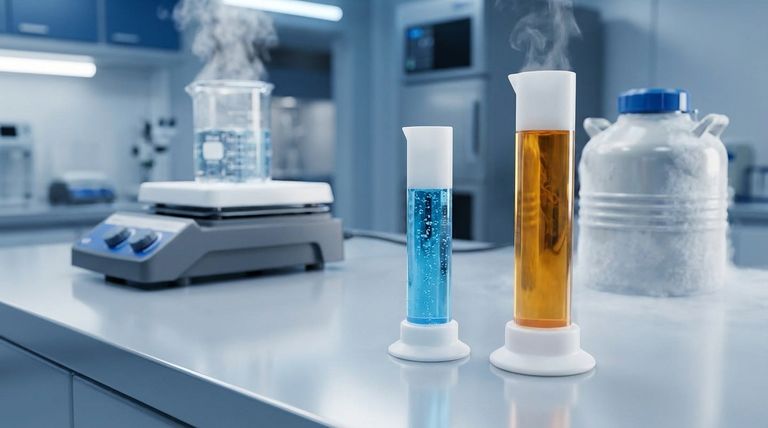In the world of high-performance materials, few polymers are as distinctive as Polytetrafluoroethylene (PTFE). More commonly known by its DuPont brand name, Teflon, PTFE is a synthetic fluoropolymer composed of carbon and fluorine. It is defined by an extraordinary combination of properties: an extremely low-friction, non-stick surface, near-total chemical inertness, and stability across a vast range of temperatures.
The true value of PTFE lies not in any single attribute, but in its unique synergy of properties. Its ability to simultaneously resist aggressive chemicals, withstand extreme temperatures, and provide a low-friction surface makes it an essential problem-solver for engineering challenges where other materials would quickly fail.

The Core Properties That Define PTFE
To understand why PTFE is specified for such demanding applications, we must look at the specific characteristics that arise from its molecular structure—the exceptionally strong bonds between its carbon and fluorine atoms.
Unmatched Chemical Inertness
The carbon-fluorine bonds in PTFE are incredibly stable and strong. This molecular structure makes the material almost completely inert.
It is resistant to nearly all chemicals, including aggressive acids, alkalis, and organic solvents. Only a few exotic substances, like molten alkali metals and hot fluorine gas, can attack it.
Extreme Thermal Stability
PTFE performs reliably across an exceptionally wide temperature spectrum. It remains functional at cryogenic temperatures and has a very high melting point of around 327°C (621°F).
This allows it to be used in environments with huge temperature fluctuations, from aerospace components to industrial ovens, without degrading.
The Lowest Coefficient of Friction
PTFE has one of the lowest coefficients of friction of any known solid material. This is the source of its famous "non-stick" quality.
This property is critical not just for cookware, but for industrial applications like self-lubricating bearings, bushings, and low-friction seals where minimizing energy loss and wear is paramount.
Superior Electrical Insulation
PTFE is an excellent electrical insulator with high dielectric strength. Its properties remain stable even at high radio frequencies.
This makes it a preferred material for insulating high-performance wires, cables, and connectors, especially in the electronics and aerospace industries.
Hydrophobic and Non-Adhesive
The surface of PTFE repels both water and oils, a property known as hydrophobicity.
This, combined with its low friction, means very few substances will adhere to its surface, making it ideal for coatings, lab equipment, and components that must remain clean and free of buildup.
Understanding the Trade-offs and Limitations
While its properties are exceptional, PTFE is not the solution for every problem. Being objective about its limitations is critical for successful application.
Low Mechanical Strength
PTFE is a relatively soft material. While it has good flexural strength—meaning it can bend without breaking—it is susceptible to creep and deformation under sustained, heavy loads.
It is not a structural plastic and can be easily damaged by high compressive forces or abrasive conditions unless it is reinforced with fillers like glass or carbon.
High Thermal Expansion
PTFE has a high coefficient of thermal expansion compared to other engineering materials.
This means it expands and contracts significantly with temperature changes. Engineers must design parts with appropriate tolerances to account for this movement, especially when PTFE is mated with metal components.
Making the Right Choice for Your Application
Choosing PTFE depends entirely on whether its unique benefits align with your primary engineering challenge.
- If your primary focus is corrosion resistance: PTFE is an almost unbeatable choice for seals, gaskets, and linings in aggressive chemical environments.
- If your primary focus is low friction: It is the go-to material for non-stick coatings, self-lubricating bearings, and bushings where minimizing drag is critical.
- If your primary focus is high-temperature electrical insulation: Its thermal stability and dielectric properties make it ideal for high-frequency wiring and connectors.
- If your primary focus is structural strength under heavy load: You should consider filled grades of PTFE or alternative engineering plastics, as unfilled PTFE's softness is a limiting factor.
By understanding both its exceptional strengths and its practical limitations, you can leverage PTFE to solve problems that are impossible for most other materials to handle.
Summary Table:
| Key Property | Benefit for Your Application |
|---|---|
| Extreme Chemical Inertness | Resists virtually all acids, alkalis, and solvents for unparalleled corrosion resistance in seals and liners. |
| Lowest Coefficient of Friction | Provides a self-lubricating, non-stick surface for bearings, bushings, and components requiring minimal wear. |
| Exceptional Thermal Stability | Performs reliably from cryogenic temperatures up to 327°C (621°F) for use in extreme environments. |
| Superior Electrical Insulation | Maintains stable dielectric properties even at high frequencies, ideal for critical wiring and connectors. |
| Hydrophobic & Non-Adhesive | Repels water, oils, and other substances, keeping labware and components clean and contamination-free. |
Leverage the unique properties of PTFE for your most demanding projects.
At KINTEK, we specialize in the precision manufacturing of high-performance PTFE components—including custom seals, liners, and labware—for the semiconductor, medical, laboratory, and industrial sectors. Whether you require a prototype or a high-volume production run, our expertise ensures you get a component that perfectly balances PTFE's exceptional properties with the mechanical requirements of your application.
Contact our engineering team today to discuss how our custom PTFE solutions can solve your specific challenges.
Visual Guide

Related Products
- Custom PTFE Measuring Cylinders for Advanced Scientific and Industrial Applications
- Custom PTFE Parts Manufacturer for Teflon Parts and PTFE Tweezers
- Custom PTFE Parts Manufacturer for Teflon Containers and Components
- Customizable PTFE Seals Filter Holders for Versatile Applications
- Custom PTFE Volumetric Flasks for Advanced Scientific and Industrial Use
People Also Ask
- What are the primary applications of Teflon? Leverage Its Unique Properties for Your Industry
- What are the common characteristics of Teflon? Unlocking Extreme Chemical and Thermal Resistance
- Why are PTFE vials considered environmentally friendly? Reduce Lab Waste with Durable Reusables
- What material is the PTFE bottle made from? Discover the Benefits of 100% Virgin PTFE
- What are some exceptional properties of PTFE? Unlock Unmatched Performance in Extreme Environments



















